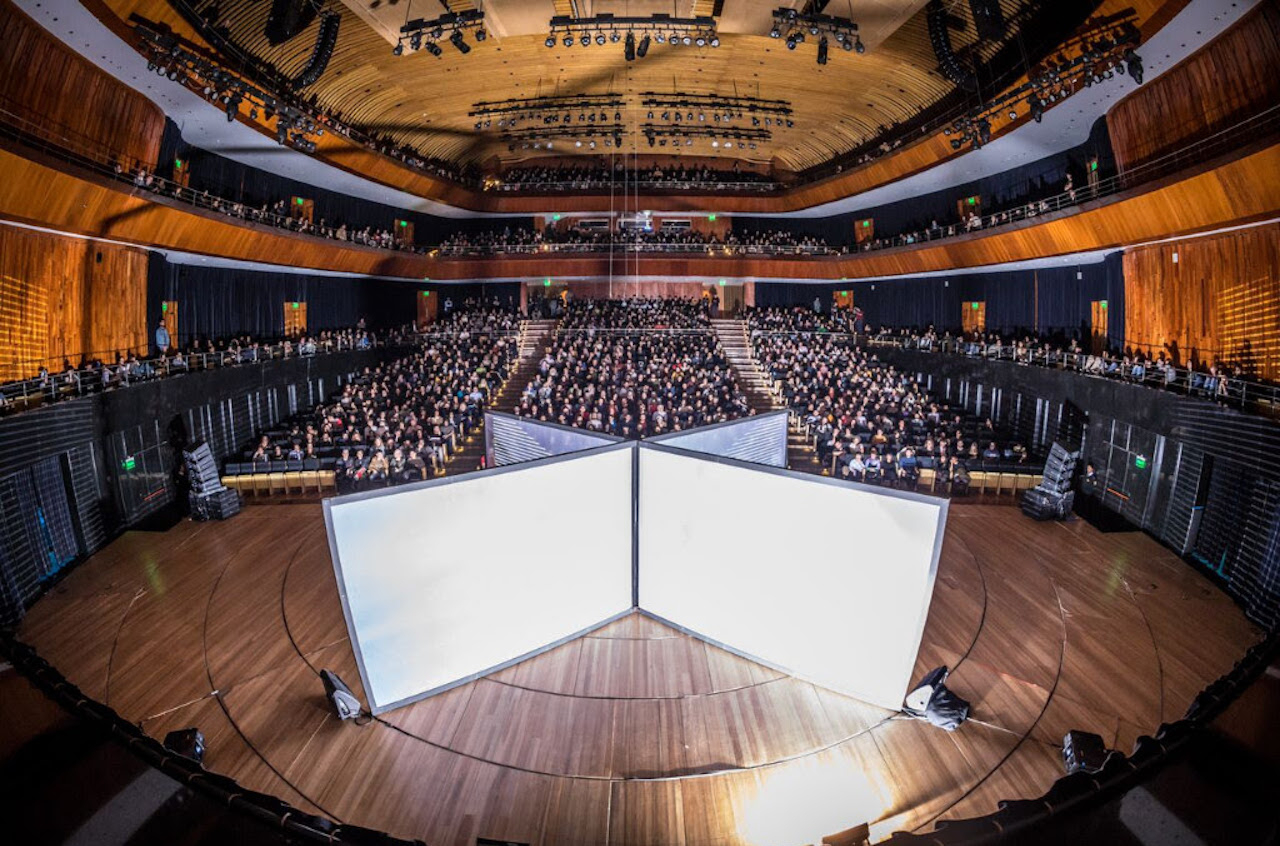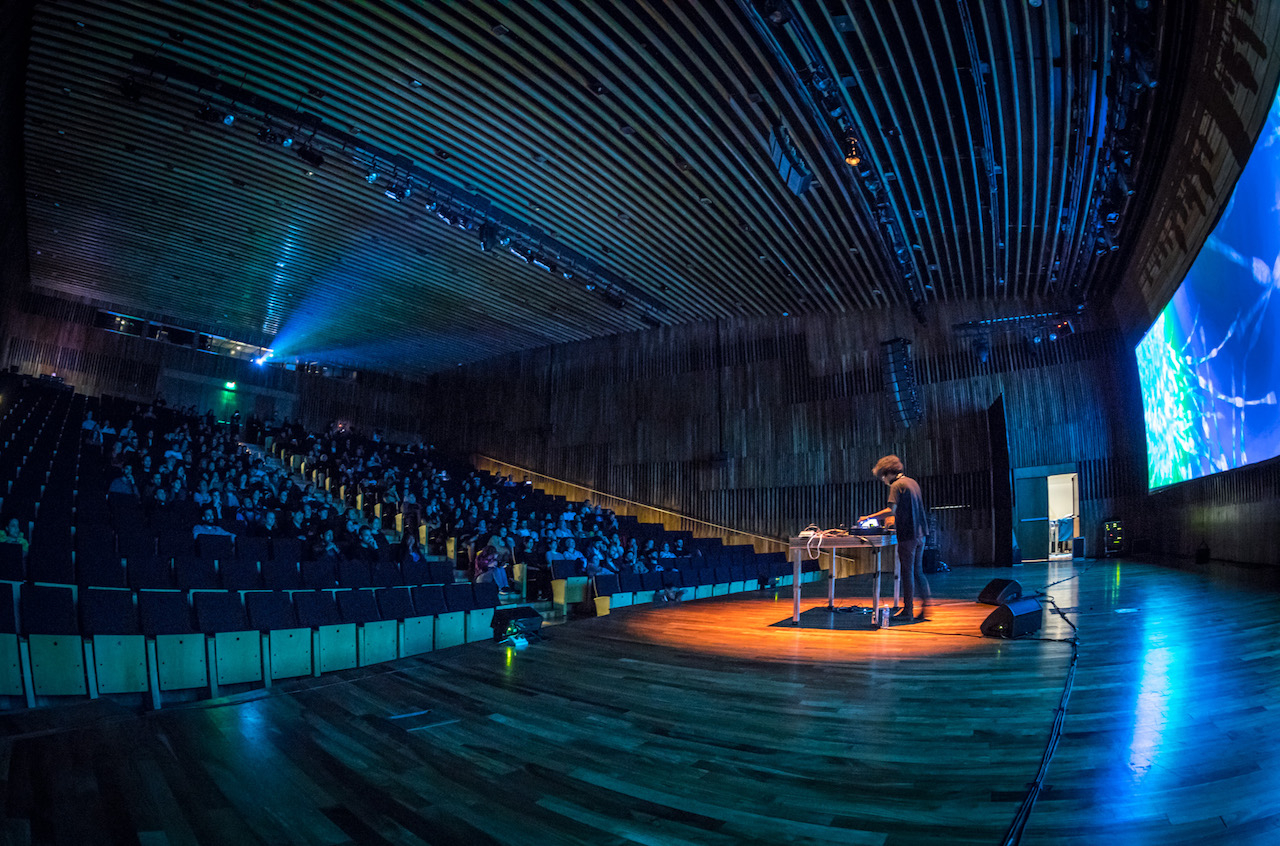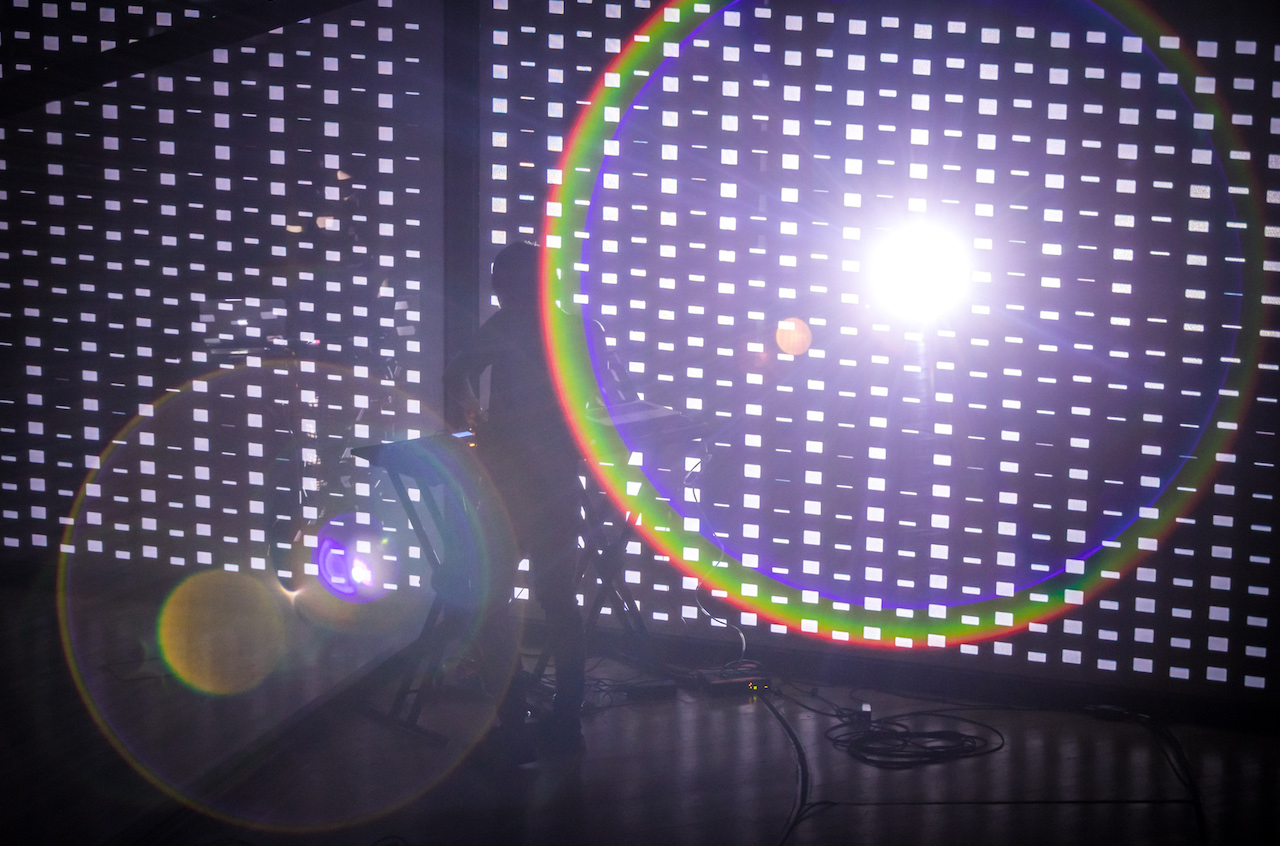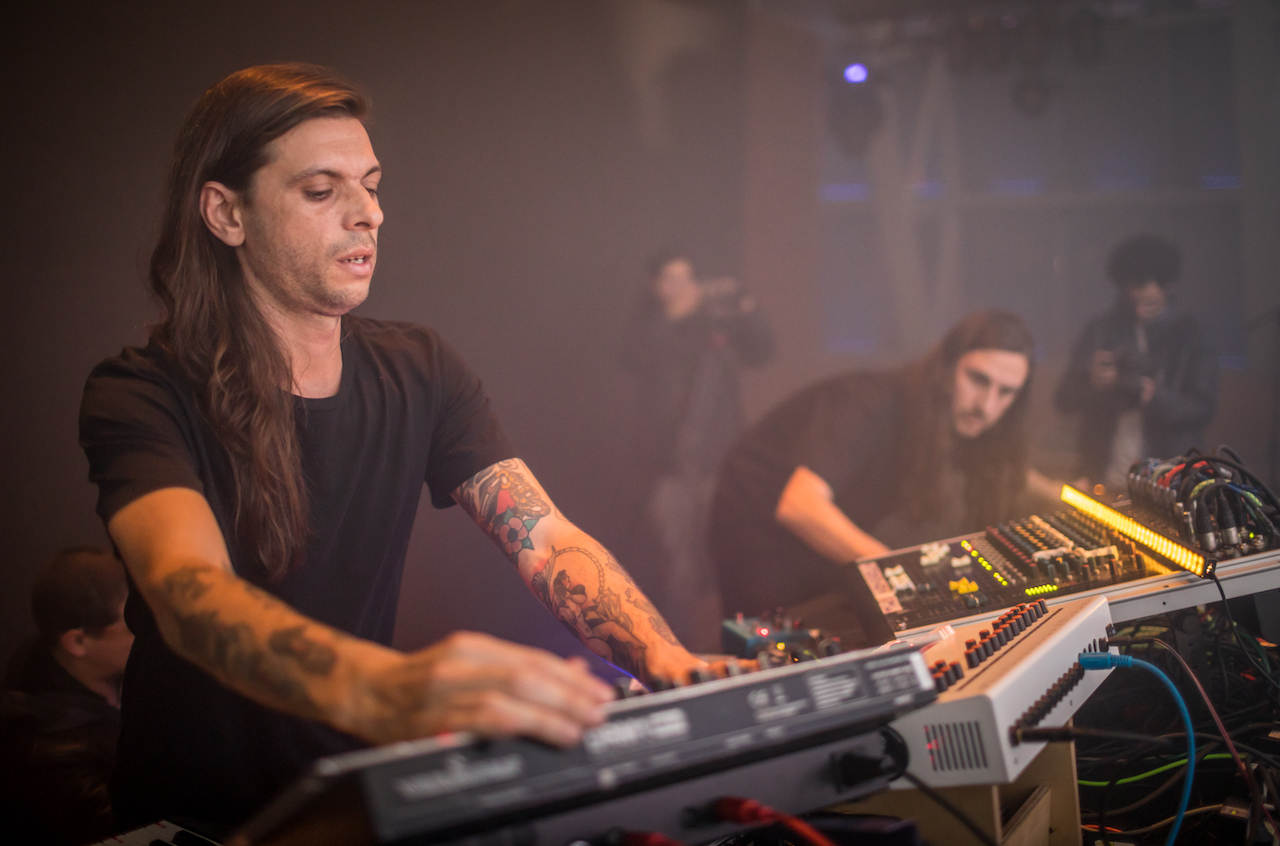- Following a solid run of annual editions between 2005 and 2010, the Canadian festival MUTEK returned to Argentina's capital, Buenos Aires, from September 22nd through 24th. The three-day event coincided with the arrival of spring in the southern hemisphere, ensuring sunny afternoons and pleasant evenings while more than 40 artists, among them musicians, DJs and visual artists, performed to mixed crowds of locals (known as Porteños) and tourists.
After Thursday night's opening concert, the Centro Cultural Kirchner (CCK) opened its doors for the first full day on Friday afternoon. The complex sits within a historical building that once served as the headquarters of the Argentine Post Office. After a complete renovation, finished in 2015, it's now home to numerous exhibition spaces and concert halls. Situated on the edge of the city centre, it was the festival's main venue, centralizing workshops, talks, installations and most of the musical performances. The entire program was free and access was strictly controlled to avoid overcrowding.
While some of the earlier time slots affected the turnout for activities like the Q&A sessions, there were always queues for the VR Salon, which offered several immersive virtual reality experiences. Later on Friday evening, a large crowd gathered in the main auditorium, Sala Sinfónica, to watch Nonotak, a collaboration from France's Noemi Schipfer and Japan's Takami Nakamoto. Entitled Shiro, the show presented a conversation between sound and light, projected onto two screens that intersected on an X-matrix. It lasted almost an hour and held the audience's attention throughout—at the end, the duo received a standing ovation. Almost all of the venue's 1,950 seats were filled.
On Saturday, the strict control of entry caused a permanently large queue outside the elevators that led to a space at the top of CCK called La Cúpula. This was where Klauss performed, with visuals by Canada's Vlacq.tv. The group, led by Argentine modular synth enthusiast Ernesto Romeo, first came together in 1988 and is now made up of Francisco Nicosia, Lucas Romeo and Pablo Gil. Performing using modulators, keyboards, sequencers and a guitar, they delivered an authentic and vibrant set. In an era when making electronic music has never been so easy, it was satisfying to watch compositions being assembled in such elaborate ways. The psychedelic visuals, coupled with the beautiful night-sky backdrop, made it even more special.
Night had fallen by the time SidiRum took the stage in Plaza Seca, CCK's largest space. Despite a small delay, the Buenos Aires artist had plenty of time to showcase his melodic and percussive sound. His performance was part of a wider lineup that shone a light on one of the most fertile waves of South American creativity around at the moment, a musical movement that brings together electronica and various regional traditional styles, often from the Andes. Marimbas, folk rhythms—mainly cúmbia—and vocals in indigenous languages interacted with beats and synthesizers. Chancha Via Circuito, maybe the best-known artist in this vein, played to a packed crowd. Unfortunately, one of the band's sound cards had been stolen the night before, though they still managed to improvise and turn the energy up a notch. Ecuadorian artists Nicola Cruz and Fidel Eljuri, who closed on Saturday, ended up being one of my highlights of the weekend. The harmony between Cruz's musicianship and Eljuri's visuals provided a rich experience, full of impressive images of Amazonian nature.
The main parties, Nocturne and Experience, took place on Saturday night and Sunday afternoon respectively. At Nocturne, which went down at popular local club Crobar, domestic talents like Ernesto Ferreyra, Seph and Alejandro Mosso joined international guests Mathew Jonson and Sonja Moonear. On Sunday, the Centro Metropolitano de Diseño—another public space—hosted a great live performance by Chic Miniature (AKA Ernesto Ferreyra and Guillaume & The Coutu Dumonts), in addition to strong sets by Mike Shannon and Maya Jane Coles, who closed the festival. Overall, the return of MUTEK Argentina was a success. It reflected the exceptional creative forces that have permeated the city for so long, while hopefully leaving a large enough trace to continue to inspire artists and audiences in the months and years to come.
Photo credit /
Marc van der Aa
 On Saturday, the strict control of entry caused a permanently large queue outside the elevators that led to a space at the top of CCK called La Cúpula. This was where Klauss performed, with visuals by Canada's Vlacq.tv. The group, led by Argentine modular synth enthusiast Ernesto Romeo, first came together in 1988 and is now made up of Francisco Nicosia, Lucas Romeo and Pablo Gil. Performing using modulators, keyboards, sequencers and a guitar, they delivered an authentic and vibrant set. In an era when making electronic music has never been so easy, it was satisfying to watch compositions being assembled in such elaborate ways. The psychedelic visuals, coupled with the beautiful night-sky backdrop, made it even more special. Night had fallen by the time SidiRum took the stage in Plaza Seca, CCK's largest space. Despite a small delay, the Buenos Aires artist had plenty of time to showcase his melodic and percussive sound. His performance was part of a wider lineup that shone a light on one of the most fertile waves of South American creativity around at the moment, a musical movement that brings together electronica and various regional traditional styles, often from the Andes. Marimbas, folk rhythms—mainly cúmbia—and vocals in indigenous languages interacted with beats and synthesizers. Chancha Via Circuito, maybe the best-known artist in this vein, played to a packed crowd. Unfortunately, one of the band's sound cards had been stolen the night before, though they still managed to improvise and turn the energy up a notch. Ecuadorian artists Nicola Cruz and Fidel Eljuri, who closed on Saturday, ended up being one of my highlights of the weekend. The harmony between Cruz's musicianship and Eljuri's visuals provided a rich experience, full of impressive images of Amazonian nature.
On Saturday, the strict control of entry caused a permanently large queue outside the elevators that led to a space at the top of CCK called La Cúpula. This was where Klauss performed, with visuals by Canada's Vlacq.tv. The group, led by Argentine modular synth enthusiast Ernesto Romeo, first came together in 1988 and is now made up of Francisco Nicosia, Lucas Romeo and Pablo Gil. Performing using modulators, keyboards, sequencers and a guitar, they delivered an authentic and vibrant set. In an era when making electronic music has never been so easy, it was satisfying to watch compositions being assembled in such elaborate ways. The psychedelic visuals, coupled with the beautiful night-sky backdrop, made it even more special. Night had fallen by the time SidiRum took the stage in Plaza Seca, CCK's largest space. Despite a small delay, the Buenos Aires artist had plenty of time to showcase his melodic and percussive sound. His performance was part of a wider lineup that shone a light on one of the most fertile waves of South American creativity around at the moment, a musical movement that brings together electronica and various regional traditional styles, often from the Andes. Marimbas, folk rhythms—mainly cúmbia—and vocals in indigenous languages interacted with beats and synthesizers. Chancha Via Circuito, maybe the best-known artist in this vein, played to a packed crowd. Unfortunately, one of the band's sound cards had been stolen the night before, though they still managed to improvise and turn the energy up a notch. Ecuadorian artists Nicola Cruz and Fidel Eljuri, who closed on Saturday, ended up being one of my highlights of the weekend. The harmony between Cruz's musicianship and Eljuri's visuals provided a rich experience, full of impressive images of Amazonian nature.
 The main parties, Nocturne and Experience, took place on Saturday night and Sunday afternoon respectively. At Nocturne, which went down at popular local club Crobar, domestic talents like Ernesto Ferreyra, Seph and Alejandro Mosso joined international guests Mathew Jonson and Sonja Moonear. On Sunday, the Centro Metropolitano de Diseño—another public space—hosted a great live performance by Chic Miniature (AKA Ernesto Ferreyra and Guillaume & The Coutu Dumonts), in addition to strong sets by Mike Shannon and Maya Jane Coles, who closed the festival. Overall, the return of MUTEK Argentina was a success. It reflected the exceptional creative forces that have permeated the city for so long, while hopefully leaving a large enough trace to continue to inspire artists and audiences in the months and years to come. Photo credit / Marc van der Aa
The main parties, Nocturne and Experience, took place on Saturday night and Sunday afternoon respectively. At Nocturne, which went down at popular local club Crobar, domestic talents like Ernesto Ferreyra, Seph and Alejandro Mosso joined international guests Mathew Jonson and Sonja Moonear. On Sunday, the Centro Metropolitano de Diseño—another public space—hosted a great live performance by Chic Miniature (AKA Ernesto Ferreyra and Guillaume & The Coutu Dumonts), in addition to strong sets by Mike Shannon and Maya Jane Coles, who closed the festival. Overall, the return of MUTEK Argentina was a success. It reflected the exceptional creative forces that have permeated the city for so long, while hopefully leaving a large enough trace to continue to inspire artists and audiences in the months and years to come. Photo credit / Marc van der Aa